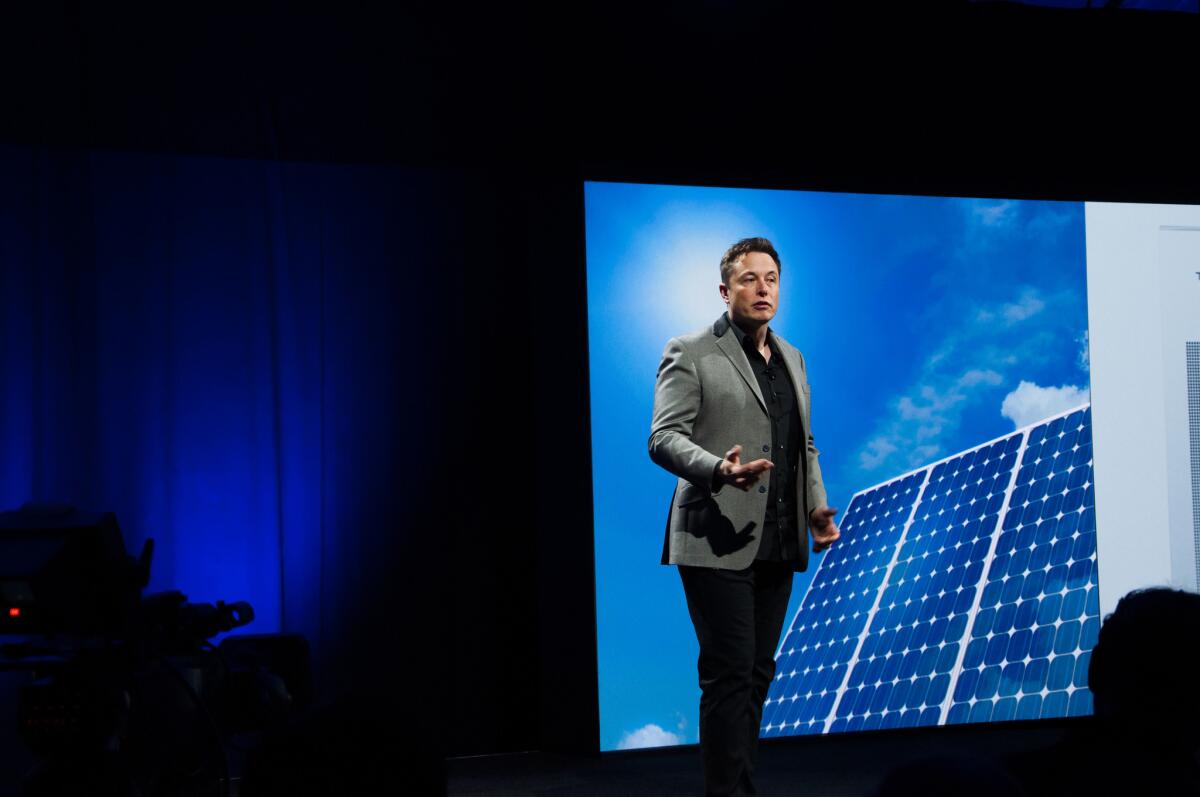Elon Musk knew SolarCity was going broke before merger with Tesla, lawsuit alleges

When Tesla bought SolarCity in November 2016, Elon Musk billed the deal as a match made in green energy heaven: Combine a hot electric car company with the nation’s then-largest provider of solar rooftop panels to create a one-stop shop for clean energy customers.
What Musk did not discuss at the time was that SolarCity was in deep financial trouble.
Just weeks after the merger, SolarCity auditor Ernst & Young concluded the company lacked “sufficient cash to meet its obligations” as a stand-alone company, according to court filings unsealed Monday that include previously redacted material.
In other words, SolarCity was nearly insolvent when Tesla shareholders voted to pay $2.6 billion for the solar panel maker and take on its debts, rescuing it from probable bankruptcy.
The filings are part of a long-running suit filed by shareholder Ellen Prasinos on behalf of all Tesla shareholders against Musk and Tesla’s board of directors, alleging they overpaid for SolarCity, ignored their own conflicts of interest and failed to disclose “troubling facts” essential to a rational analysis of the proposed deal.
One allegation: SolarCity hid information from Ernst & Young about two payments due to lenders that should have been used to determine SolarCity’s financial condition.
In its motion, the plaintiff seeks summary judgment from the Delaware Chancery Court on key parts of the SolarCity case.
Tesla has not yet filed a court response.
Tesla issued a statement to The Times on Monday evening: “These allegations are based on the claims of plaintiff’s lawyers looking for a payday, and are not representative of our shareholders who support our mission and ultimately voted in favor of the acquisition. The accusations made in the plaintiff’s brief are false and misleading, as Tesla and SolarCity published all material information in its proxy and other public filings for all shareholders to consider before deciding on the transaction.”
In a lengthy and detailed court filing last year, Tesla took issue with and responded to dozens of allegations contained in the lawsuit.
The plaintiffs allege that close ties between Tesla and SolarCity before the merger resulted in decisions that didn’t benefit shareholders. Musk was chairman and chief executive of Tesla as well as chairman and the largest individual shareholder of SolarCity. SolarCity was founded by Musk’s cousins, Lyndon and Peter Rive, who ran it and sat on its board. Musk’s brother, Kimbal, is a Tesla board member and was a SolarCity board member too.
Several other Tesla board members were also directly connected to SolarCity at the time, including:
- Brad Buss, SolarCity’s chief financial officer six months before the merger was announced.
- Ira Ehrenpreis, a Tesla board member whose investment fund had a representative on the SolarCity board.
- Antonio Gracias, an early investor in both Tesla and SolarCity and a board member at both.
Despite the connections, only the Musk brothers refrained from voting on the SolarCity deal.
In a further entanglement, another Musk company, the privately financed SpaceX, had loaned money to SolarCity to help keep the solar panel company’s cash position from dipping below $169 million, an event that would have triggered a bond default and possibly led to bankruptcy.
Material taken from emails, documents, depositions and other evidence unsealed Monday tells a story of SolarCity’s deepening financial crisis leading up to the merger with Tesla.
By September 2015, SolarCity was holding weekly cash management meetings in an attempt to keep the company afloat as its sales and revenue declined. The next month, Chief Executive Lyndon Rive and CFO Buss allegedly told Elon Musk the company needed $180 million to $300 million in cash. According to the filing, SolarCity contacted several investment banks and private equity investors for new equity or convertible bond investments and was told no.
By February 2016, the SolarCity board was struggling with how to avoid a bond default. According to the filing, Rive and Musk met separately to come up with ways to conserve cash, and later in the month, Musk told Tesla’s chief financial officer to prepare a pitch for a SolarCity acquisition to Tesla’s board.
By April, SolarCity board members heard from Rive and others that solar panel installations were expected to decline 28% for 2016, but the lawsuit alleges that the information never made its way to public investors.
The filing quotes “internal bookings reports” at SolarCity using terms like “drenched in a sea of red.”
Elon Musk finally found a way to turn his Wall Street fans into doubters.
On June 21, 2016, the merger plan was announced, just weeks after Tesla raised about $1.5 billion in a secondary stock offering. When the SolarCity deal was announced, Tesla stock dropped 10%.
Musk insists that by recusing himself from voting on the merger, he avoided a conflict of interest. In a recent deposition, he said “I could not be recused from all discussions. I needed to voice my opinion, obviously.” He voiced his opinions by lobbying investors, according to the filing, which claims Musk told his executive assistant he needed to talk to major investors who were either neutral or negative about the merger.
In October 2016, Musk whipped up solar-product excitement by unveiling a “solar roof” on the old set of ABC’s “Desperate Housewives.” The roof integrated solar cells with shingles, which were to be sold through Tesla stores and available for commercial deployment.
The shingle Musk held turned out to be fake, but that was not widely known when Tesla shareholders voted to acquire SolarCity in November, 2016.
The plaintiffs seek yet-to-be-determined damages and restitution to be paid by Musk and the board members to Tesla, which is owned by its shareholders.
More to Read
Inside the business of entertainment
The Wide Shot brings you news, analysis and insights on everything from streaming wars to production — and what it all means for the future.
You may occasionally receive promotional content from the Los Angeles Times.











